Production Notes - Die Another
Day
After the global success of "The
World Is Not Enough" in
1999, Pierce Brosnan had
completed his contract for three films, and chose to take a short
break from Bond before exercising his
option for a fourth 007 outing. Claiming an extra year between
movies
would help improve the quality of the story, Brosnan completed "The
Tailor of Panama" and his personal project "Evelyn" before
returning for what would ultimately be his final foray as
007.
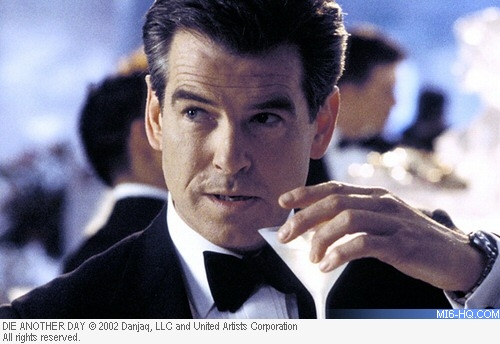
Above: Pierce Brosnan as James
Bond for the fourth and final time.
|
Scribes Neal Purvis and Robert
Wade were asked back to pen their second Bond script, and turned
to Ian
Fleming's novels for inspiration.
As the 1979 adaptation of "Moonraker" had
born little resemblance to its literary
roots, Purvis and Wade mined the
novel for elements, including: the patriotic British gentlemen's
image hiding an unscrupulous villain, a Blades Club face-off,
and the character of Gala Brand. Their female foil would undergo
several changes, and by the time shooting started, she had deviated
so much from the source material they renamed her (with help
from actress Rosamund Pike)
to Miranda Frost. Extending a subplot from their previous film
where Bond carried an injury, the writers
this time damaged the central hero further, making him redeem
his 00-status following his capture and torture.
|
When director Lee Tamahori was brought
on board (Brett Ratner, Stuart Baird and Stephen Hopkins
were considered to direct the movie), he demanded several
changes to the script, most notably adding a CGI para-surfing
stunt sequence and changing the final showdown between
Bond and Graves from an indoor beach resort in Japan to
an airborne finale over the Korean DMZ.
Some of his more
risque suggestions, such as having a dozen PVC cat-suit
clad girls chasing Bond back to his car at the Ice Palace,
would be dropped from the final cut.
A few months before shooting was scheduled
to start, on August 11th 2001, an old friend made a long-over
due return to the series, when EON
announced Aston Martin would be supplying Bond's wheels
again.
Casting was an almost last-minute affair.
Four weeks before filming began, the only parts that had
been cast were the MI6 regulars - Pierce Brosnan (007), Judi
Dench (M), Samantha
Bond (Moneypenny), Colin
Salmon (Robinson) and John
Cleese (Q).
Rosamund Pike was hired to play Miranda
Frost just five days ahead of principal photography.
|
|
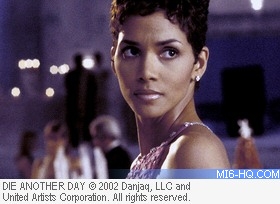
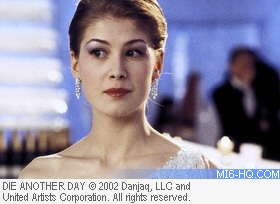 Above:
Halle Berry as Jinx (top) and
Rosamund Pike as Miranda Frost. Above:
Halle Berry as Jinx (top) and
Rosamund Pike as Miranda Frost.
|
The identities of three
unsuccessful Bond Girl screentests were revealed by Salmon
(who stepped in to Bond's shoes for the casting) as Saffron
Burrows, Salma Hayek and Sophie Ellis Bextor. The seemingly
endless stream of information appearing in the press lead casting
director Debbie McWilliams to joke that someone must have been
going through her garbage. The casting
of Halle Berry as the lead
'Bond Girl' drew headlines around the world, but necessitated
further late changes to the structure
of the story. This is most apparent during the Ice Palace scenes
where Bond yo-yo's in and out of the villain's lair - breaking
Cubby Broccoli's
rule of "never going back to the same place
twice".
|
In December 2001, just days before filming
on Bond 20 was to start, a UK actor's strike potentially
threatened the schedule. However, EON Productions allegedly
struck a deal with the UK Actors' Equity Union which meant
that production could proceed regardless of the outcome
of the dispute had it not been resolved.
The kick-off press conference and photo
call was held at Pinewood Studios on January 11th 2002
with Brosnan, Berry, Pike, Toby
Stephens (Graves) and Rick Yune (Zao) in attendance.
Principal photography of "Bond 20" - as it was
known then - began the same day with Brosnan suffering
through a heavy cold as he switched between filming his
MI6 office scenes and meeting the world's media.
It would be two months after the press
conference, where Brosnan joked they were open to suggestions
for titles as they had ran out, that EON
announced via a statement that James Bond would "Die
Another Day" in his 20th film. Wilson and Broccoli
said the title "carries on the tradition of the Ian
Fleming stories and reflects the excitement and mystery
of our latest script”. It was derived by Wilson from
a phrase from the poem "A Shropshire Lad" by
A.E. Housman: "But since the man that runs away /
lives to die another day". |
|
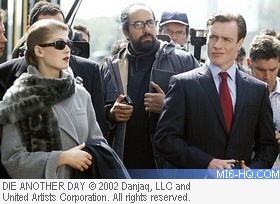
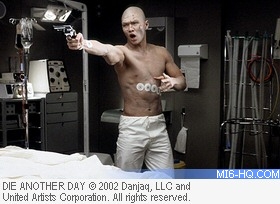 Above:
Toby Stephens as Gustav Graves attending Buckingham
Palace (top), and Rick Yune as Zao (above). Above:
Toby Stephens as Gustav Graves attending Buckingham
Palace (top), and Rick Yune as Zao (above).
|
Just a few days later, Madonna
was announced as the title song artist on March 11th. "She
is starting work in the studio on Monday (18th March 2002)",
confirmed her publicist."It
is true that part of the contract was to have a cameo role in
the movie, but her commitments to her new play in London means
it is no longer possible". Schedules were reworked and Madonna
was given lesbian undertones in the role of Verity, Frost's fencing
instructor. It was the final scene shot during principal photography
on July 27th. When Bond introduces himself to Gustav before they
fight, Madonna was originally to introduce him with the catchphrase, "Bond.
James Bond." However, it was later decided that the audience
would prefer the line coming from Brosnan.
Halle Berry left the production for a couple of days to attend
the 2002 Oscars, where she won Best Actress and became the first
Academy Award winner to be a leading Bond Girl in the EON Productions
series. Rosamund Pike also had to leave the film set for one
day for an awards ceremony too - her English Literature graduation
at Oxford University.
As well as Pinewood Studios and its historic 007 Stage, the
film was shot primarily in the United Kingdom, Iceland, and Cádiz,
Spain. Other locations included scenes shot in Maui, Hawaii,
where Laird Hamilton and other professional surfers were hired
to perform the pre-title surfing scene on Christmas Day 2001.
Holywell Bay near Newquay in Cornwall doubled for the exteriors
of the North Korean beach, where Brosnan picked up the rest of
the action for the sequence before moving to the back-lot at
Pinewood. Scenes inside Graves' diamond mine were filmed in Cornwall,
at the Eden Project, in early March.
|
The scenes involving the Cuban locations
Havana and the fictional Isla Los Organos were filmed at
La Caleta, Spain.
Also in Spain, the scenes featuring Berry
in a bikini were shot in Cádiz. The location was
unusually cold, windy and rainy, and footage was released
of Berry wrapped in thick towels between takes to avoid
catching a chill.
Berry was slightly hurt during filming
when debris from a smoke grenade flew into her eye causing
a scratched cornea. She was treated with eye drops at
a local hospital. The US media ran exaggerated stories
of
dust, grit, grenades and even a flying rock.
It was not the only time Berry would suffer
on set. As Brosnan recalled of the Cuban love scene, "Halle
had this piece of fruit in her hand and she gives me some,
then puts it in her own mouth. I made a joke and she started
laughing and then she gagged. Suddenly there was no sound
coming out. I banged her on the back, then began putting
my arms around her to do the Heimlich. Somehow she expelled
the fruit which was a good thing, because I've never given
anyone the Heimlich before." |
|
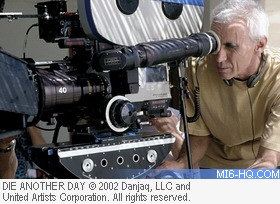
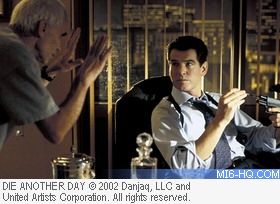 Above:
Lee Tamahori directs the action. Above:
Lee Tamahori directs the action.
|
Brosnan suffered himself during the filming
of the opening teaser sequence. The cold and slippery surfaces
in Aldershot, UK, caused
havoc for the world`s most famous secret agent. "I didn't
warm up. It was as simple as that. You really need to stretch,
and I just kind of ran through those paces. I suddenly realised
that I had to do a 200-yard-dash with 500 extras, six cameras,
explosions, one thing and another, and the knee just went. It
was a cold February morning." Shortly afterwards Brosnan
flew to the US for a small operation on the damaged knee before
filming continued 7 days later. It was the first time in the
series' 40 year history that a Bond movie was briefly shut-down
due to the unplanned absence of its star.
Back in London, the Reform Club was used to
shoot several places in the film starting on May 26th, including
the lobby at the
Blades Club, MI6 Headquarters, Buckingham Palace, Green Park,
and Westminster. Location manager Simon Marsden had to negotiate
long and hard with the appropriate authorities to secure permission
to film
Gustav Graves' parachute jump over Buckingham Palace. His negotiations
were further complicated by the death of the Queen Elizabeth
the Queen Mother. The action was shot at first-light before
the regular crowds of tourists would have made it impossible.
Svalbard, Norway and Jökulsárlón,
Iceland were used for the car chase on the ice with additional
scenes filmed at Jostedalsbreen National Park, Norway and RAF
Little Rissington, Gloucestershire. Although a quarter of the
movie is set there, Brosnan didn't have to travel to Iceland
as the Ice Palace was created at Pinewood, with additional pick-up
shots from the locale recreated in an English car park with cardboard
cutouts standing in for glaciers.
|
A real-life 'Q-Branch' of special effects
gurus had spent months heavily modifying the Aston Martin
DBS and
Jaguar
XKR cars
so they could operate on the ice and at the sub-zero temperatures.
The frozen lake in Iceland used for the
car chase does not naturally freeze very often due to
its closeness to the sea and its high salt content. The
action
unit had trouble getting the lake to freeze properly,
so they had to consider moving the sequence to ice in New
Zealand.
With time quickly running out before the call
had to be made, the team damned the river that
links the lake to the sea
and
within
two
days
the
entire
lake was frozen
to a depth of over 2 meters.
The scene where Bond surfs the wave that
Icarus created when Graves was trying to kill Bond was
shot on green screen. The waves and all of the glaciers
in the scene were digitally produced.
The effects company
behind the CG sequence reportedly spent so much effort
achieving the quality required for the waves and icebergs
that they left insufficient time to properly composite
the Bond character.
This experiment in using a digital
Bond to achieve a stunt sequence was lambasted by the
stunt industry and mocked in many reviews of the film. |
|
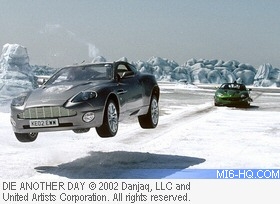
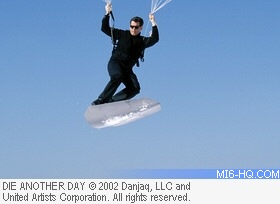
|
The hangar interior of the "US
Air Base in South Korea",
shown crowded with Chinook helicopters, was filmed at RAF Odiham
in Hampshire, UK, as were the helicopter interior shots during
the Switchblade sequence although this took place entirely on
the ground with the sky background being inserted later with
blue screen techniques. Although in the plot the base is American,
in reality
all the
aircraft and personnel in the shot
are British. In the film, a Switchblade (one-man glider shaped
like a fighter jet) is used by Bond and Jinx to enter North Korea
undetected. The Switchblade was based on a workable model called "PHASST" (Programmable
High Altitude Single Soldier Transport).
Graves' plane was a
20-foot wide model that was controlled by a computer. When
the plane flew through the Icarus beam, engineers cut the plane
away
piece by piece so that it looked like it was burning and falling
apart. Filming of Graves boarding his Antonov in North Korea
was captured
in Manston Airport, near Ramsgate, England in early
May. The
production then moved to an MOD
base in Aldershot to complete
the pre-titles hovercraft chase under the supervision of Action
Unit director Vic Armstrong.
Originally planned to be shot on the beach in
Cádiz,
the final love scene was filmed in a specially created 'Buddhist'
temple on the West coast of Wales. The appearance of religious
artifacts in the love scene would later cause a publicity storm.
The earlier sex scene between Bond and Jinx — the first
time onscreen in the series in which Bond is depicted actually
having sex as opposed to a post-coital scenario — had to
be trimmed for the American market. An early cut featured a brief
moment — seven seconds in length — in which Jinx
is heard moaning strongly. The MPAA ordered that the scene be
trimmed so that the film could get the expected PG-13 rating.
The scene was cut as requested, earning the film a PG-13 rating
for "action violence and sexuality".
|
Wide publicity for "Die Another Day" kicked
off on 10th August 2002 when MGM revealed the first titled
poster for the movie, featuring Brosnan and Berry. In early
October, the theatrical trailer was released in front of "Red
Dragon" in the USA. Trailers were also played at screenings
of "Austin Powers in Goldmember" due to an out-of-court
settlement among MGM, Danjaq and New Line.
In post-production, while the film negative
went through the traditional photochemical printing process,
the entire first reel, including the opening pre-title
sequence, was instead digitally graded. The digital lab
also worked on the Hovercraft battle sequence, creating
a gritty look with enhanced explosions through to Bond's
eventual release from captivity as well as a key sequence
that would normally have required sky replacements.
With all the edits complete, the Royal
Albert Hall was transformed into an Ice Palace for the
World Royal Premiere on 18th November 2002 with the
help of 500 twenty-foot artificial icicles on loan from
Germany and more red carpet than the Oscars. |
|
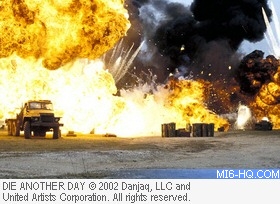
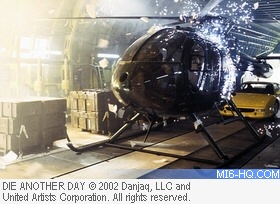
|
The Royal Annual Film Performance
lured stars from past and present to the biggest premiere a Bond
film had ever seen. Among the previous cast members attending
were Britt Ekland, Fiona Fullerton, Richard Kiel, Maud Adams,
Shirley Eaton, Lois Chiles and theme song legend Shirley Bassey.
With Her Majesty Queen Elizabeth II in attendance and the series
celebrating 40 years on the silver screen, an unprecedented meeting
took place of former 007 stars - George
Lazenby, Sir Roger Moore,
Timothy Dalton and Pierce Brosnan all attended. Sir
Sean Connery claimed he could not be there due to filming commitments. Meanwhile
in Leicester Square, an almost simultaneous screening at Empire
UCI was getting under way to accommodate the unbelievable response
for tickets. The screenings at the Royal Albert Hall and Empire
UCI raised approximately £500,000 in aid of the Cinema & Television
Benevolent Fun, a charity that helps the people behind the cameras.
The opening weekend total for "Die Another
Day" in
the USA broke the Bond record books when it took an amazing $47.1m
- surpassing the previous record of $35.1m by "The World
Is Not Enough". It also broke through the $100m US box office
target faster than any Bond movie ever before. It became the
highest international grossing James Bond picture of all time
with a $264.9m international cumulative score, overtaking the
$242m set by "GoldenEye". The
holdovers were impressive, too. In its second weekend in the
UK the picture knocked Harry
Potter off the top spot. After just 10 days on release, "Die
Another Day" had grossed 90% of the final box office for
1997's "Tomorrow Never Dies".
The movie also set a new record for merchandising,
with $120 million worth of deals with 24 various companies for
product placement and/or tie-ins. It was reported that these
deals covered the production budget even before cameras had rolled.
The film's success extended outside of the box-office
too. Less than a month after its release, UK fencing clubs saw
an increase
in the number of people interested in taking up the sport. Iceland
had a noticeable increase of tourist interest, mostly from people
seeking to stay in an ice hotel such as the one shown in the
film, even though no such structure exists in the country.
But due to its plot, the film was bound to cause
a stir in the Korean peninsula, although nobody could have predicted
the strength
of the protests. Both
North and South Korea found reasons to launch boycotts against
Bond's latest adventure.
|
Shortly before the film opened in the
territory, a 20th Century Fox Korea spokesmen anticipated
the ill feeling towards the film and said: "There
are some misunderstandings of the movie. The enemy described
in the movie is extreme nationalists, not North Korea".
But director Lee Tamahori poured fuel on the fire by saying: "To
hell with North Korea. It's a basket-case country and the
sooner its leaders all roll over and die, the better." This
caused the Secretariat of the Committee for the Peaceful
Reunification of the Fatherland to issue a statement calling
for an end to the screenings and saying the film was a "dirty
and cursed burlesque aimed to slander North Korea and insult
the Korean nation".
Korean-American actor Rick Yune,
who played Zao, tried to quell the controversy by saying: "The
enemy in the movie is not North Korea, but the individual
he plays". He also went on to say that "the movie
has nothing to do with Bush's characterisation of North
Korea in January 2001 as part of an 'axis of evil' because
the story was written four years ago".
Meanwhile, south of the border, a national
boycott was attempted on the grounds that the film depicted
South Korea as a US Colony, and activists claimed boycotting
the film was necessary in order to protect national pride. |
|
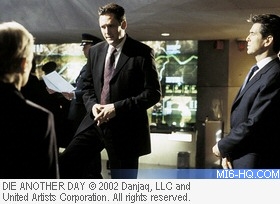
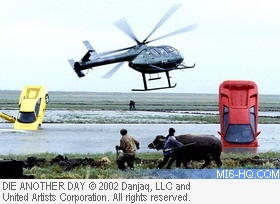
|
Further controversy arose when South
Korean Buddhists discovered Bond and Jinx make love in a Buddhist
temple at the end of the film. The Jogye, South Korea's largest
Buddhist order, issued a statement saying: "This is a slight
to Buddhism, which has purified the culture and mind of mankind
for 2,700 years". A cinema outside of Seoul finally bowed
to pressure and cancelled all showings of "Die Another Day" after
less than a week of release in the country. Despite the protests
(infact some cinema goers said they were going because of
all the media attention) "Die Another Day" opened well
in both North and South Korea, but dropped out of the top ten
by its second week resulting in takings down to approximately
65% of the level achieved by the previous film.
"Die Another Day" completed its global release in
Japan on February 2nd 2003 with its premiere
in Tokyo.
Although three premiere screenings were held during the day to
accommodate high demand, few celebrities turned out and it was
a rather low-key affair.
When the dust had settled, "Die Another Day" had taken
an astonishing $160.9m in the USA and a worldwide total of $431.97m
- a new series record high.
A spin-off was planned, featuring Halle Berry's character Jinx
as the lead. Purvis and Wade wrote for two months and director
Stephen Frears was hired to helm. However, after the failure
of other female-character-driven action films like "Charlie's
Angels: Full Throttle" and "Lara Croft Tomb Raider:
The Cradle of Life", MGM
pulled the plug on the project.
Critical reception to "Die Another Day" was
mixed with many long-time fans expressing disappointment at the
outlandish
turns the film took after the otherwise well-received first reel.
Sir Roger Moore actively voiced his displeasure with the film,
citing
the
invisible
car
and the weak CGI as being a low for the series. "I thought
it just went too far — and that’s from me, the first
Bond in space!", he said. "Invisible cars and dodgy
CGI footage? Please! They gave the public what they wanted, though
maybe they too realised there was only so far they could push
it before Bond became a caricature of himself, and the funeral
directors were called in. "
It was this creative cul-de-sac that caused producers Michael
G. Wilson and Barbara
Broccoli to quietly make a decision that
would shock the movie industry and many Bond fans. Despite breaking
series records at the box-office, and with Pierce Brosnan's contract
of 'three
with an option for a fourth' completed, James Bond would be taken
back to his roots and rebooted for
an origin story with a new
leading man.